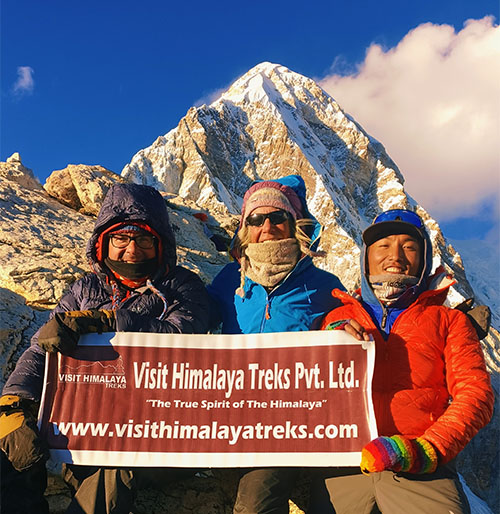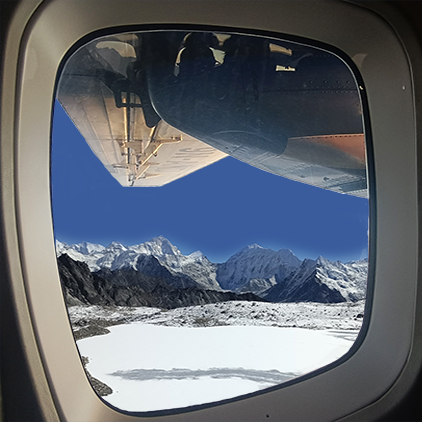A hidden treasure in Nepal's Manaslu region, the Tsum Valley offers trekkers an off-the-beaten-path Trek in the remote Tsum Valley.
This adventure takes you to a wonderful isolated valley where you may escape reality and the bustle of the city. The route takes you through traditional hamlets in the beautiful Himalayas, known for its unspoiled scenery, historic monasteries, and rich Tibetan culture. The Tsum Valley is an excellent choice for those looking for solitude and a profound cultural immersion since it is less popular than other well-known trekking routes in Nepal. Experience a spiritual adventure into one of the most concealed valleys in the Himalayas, rewarded with stunning vistas of Manaslu and Ganesh Himal.
About Tsum and Nubri Valley.
Tsum and Nubri Valley lies in the Tsum Nubri Rural Municipality in northern Gorkha, Nepal. Tsum Valley is a peaceful paradise set in the shadow of the beautiful Himalayas in Nepal's Manaslu region. This isolated valley, previously inaccessible to outsiders, continues to preserve its old culture and customs, providing a unique peek into a way of life completely unaffected by modern influences. Unlike Nepal's more popular trekking routes, Tsum Valley is a haven for people seeking serenity, tranquillity, and a strong connection with nature.
The valley has strong Tibetan Buddhist roots and is a spiritual sanctuary. Monasteries, stupas, and mani walls line the valley, each offering quiet witness to its sacred heritage. The inhabitants living in Tsum Valley are just as fascinating as the surrounding scenery. They are called Tsumbas and are extremely spiritual, kind, and pleasant. Their distinct Tibetan customs, language, and dress provide a special cultural dimension to the trekking experience.
As you traverse the meandering trails of Tsum Valley, you will pass through gorgeous settlements, each with its unique character. The sight is timeless in its splendour, with terraced fields, prayer flags billowing in the breeze, and stone homes. Along with its breathtaking natural features, the valley is home to the serene streams of the rivera and the majestic peaks of Sringi and Ganesh Himal.

Old Traditional Buddhist Stupa Tsum Valley.
Local Cultural Tradition in Tsum Valley.
Tsum Valley is a location where time pretends to stand still, delivering an unforgettable glimpse into a historical and thriving human civilization. Hidden up in the far-off Himalayas, this valley is one of the few in Nepal where people still practice Tibetan Buddhism daily. The Tsum Valley community has a diverse range of long-standing rituals, traditional ways of life, and spiritual activities that have been passed down through the ages.
The Center of Spirituality in Tsum Valley.
Tsum Valley's culture revolves around its deep spiritual history. The valley is full of monasteries, chortens (Buddhist shrines), and prayer walls. These sacred architectures are more than just symbols of religion, they are essential to the community's daily existence. Spiritual monasteries like Mu Gompa and Rachen Nunnery serve as hubs for education and contemplation, with monks dedicating their whole lives to spiritual practices. Ancient customs including prayer ceremonies and prayer wheel rotations, which are meant to spread spiritual blessings over the valley, are on display for visitors visiting Tsum Valley.
The inhabitants of Tsum Valley practice Nyingma, a kind of Tibetan Buddhism that highlights meditation and compassion. The valley's spiritual head is said to be a reincarnation of a renowned lama, and the locals respect him strongly. Celebrations are held with considerable enthusiasm, such as Lhosar, the Tibetan New Year. Visitors get the opportunity to personally witness the spiritual richness of the valley during these celebrations, which are highlighted by prayers, dances, and feasts.
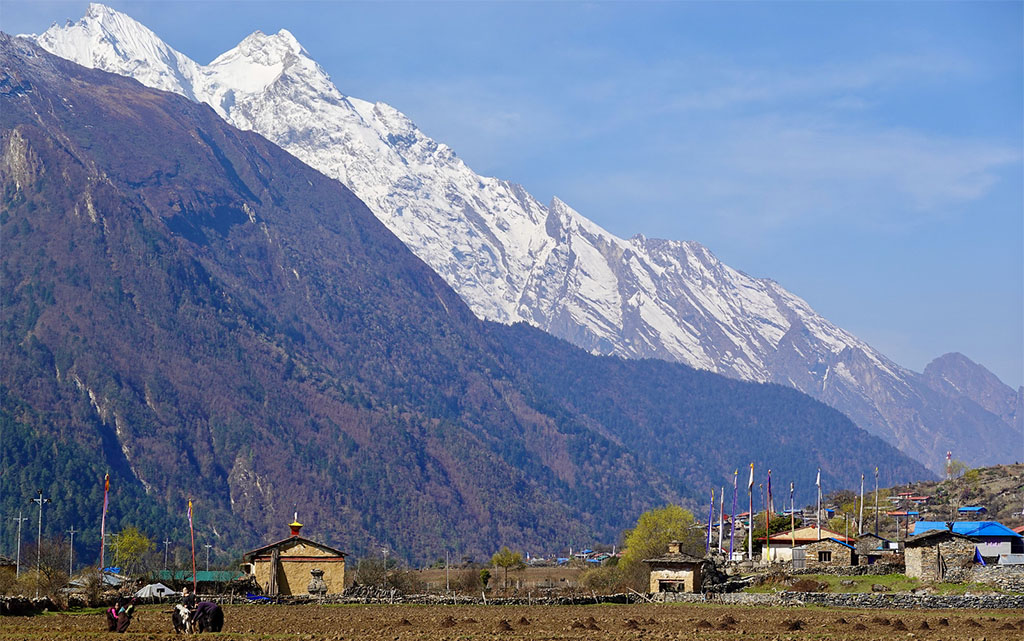
Wonderful local village and their daily lifestyle in Tsum Nubri Valley.
Daily Lifestyle in Tsum Nubri Valley.
The inhabitants of Tsum Valley, known as Tsumbas, live a life that is strongly rooted in the land and their traditions. The main industry is agriculture, and the principal crops are barley, potatoes, and wheat. The Tsumbas practice farming for survival, depending on the crops and cattle they raise. Yaks are crucial to their way of life, producing milk, butter, and wool. To survive the severe Himalayan winters, homes in Tsum Valley are usually made of stone and have flat roofs. These homes are frequently decorated with vibrant prayer flags that wave in the cool breeze signifying the spread of caring and giving. A central fireplace acts as the focal point of family get-togethers inside the warm and inviting interiors of the residences.
Traditional Attire and Clothing.
Tsum Valley's language is a Tibetan dialect, reflecting the region's strong cultural links to Tibet. The Tsumba language is still extensively spoken in the valley, despite the growing impact of Nepali and English, particularly among the younger population. It plays a crucial role in maintaining the valley's distinct cultural legacy and is an essential part of the local character. The traditional clothes of Tsum Valley are likewise uniquely Tibetan. Men wear woollen robes known as "chubas," while women tend to be wearing brightly coloured aprons known as "pandan," which indicate the state of their marriage. The clothes are warm and functional, appropriate for the cold weather in the valley, and made of thick wool.
Lifestyle in Tsum Valley.
Tsum Valley residents have a distinctive way of life that combines resiliency, tradition, and simplicity. People in this isolated Himalayan valley coexist peacefully with nature and their cultural legacy, apart from the rush of modern society. The difficult terrain and severe environment have an impact on every part of their daily lives. However, Tsum Valley's inhabitants hold onto a strong sense of spirituality and community that describes their way of life.
Farming and Living Conditions.
In Tsum Valley, agriculture is the main source of livelihood. For the most part, the Tsumbas cultivate for survival. They raise crops that are ideal for the high-altitude conditions of the valley, such as potatoes, wheat, and barley. As a result of the cold temperature and short growing season, Tsumbas put in a lot of effort during the summer to secure a healthy crop. Instead of using modern machinery, they employ physical labour and animal power in their old farming practices.
In Tsum Valley, livestock is equally important. Yaks and sheep produce milk, butter, and wool. Utilizing every aspect of the animal, the Tsumbas show their creative abilities and respect for the natural world. Yak herding is popular in the valley, with herdsmen taking their animals to high pastures during warmer seasons. This agricultural lifestyle is a key component of the valley's culture, passed down through generations.
Residence and Surroundings of Tsum Valley.
Tsum Valley's architecture reflects its inhabitants' regular requirements. The stone used to build houses is gathered locally, and the flat roofs are made to face the significant snowfall. These strong homes are meant to survive for many generations. The homes are pleasant yet basic on the inside. A central fireplace offers warmth and serves as the home's center point, where families gather to cook and enjoy meals. In the Tsum Valley, villages are modest and tightly linked. Everyday activities revolve around community life. People cooperate during harvests, construction projects, and religious events. There is a strong spirit of collaboration and mutual support. Every household contributes to the general well-being of the community, and the idea of "self-sufficiency" is strongly established.
Nutrition and Eating Habits.
Tsum Valley inhabitants have a basic yet healthful diet. Tsampa, or barley flour, is a common basic meal. The Tsumbas typically consume it with yogurt or butter tea in combination. Potatoes, another important crop, appear in a variety of recipes. Dairy goods, which include cheese, yogurt, and butter, are also essential; yak butter is a highly valued component. The eating customs of the Tsum Valley people are closely associated with their Buddhist faith. Particularly on holy holidays, the Tsumbas follow strict dietary guidelines. To show their respect for all living things, many people go vegetarian for a particular amount of time. In the Tsum Valley, food is not wasted. Every meal is valued by the people, who realize the effort required to prepare it.
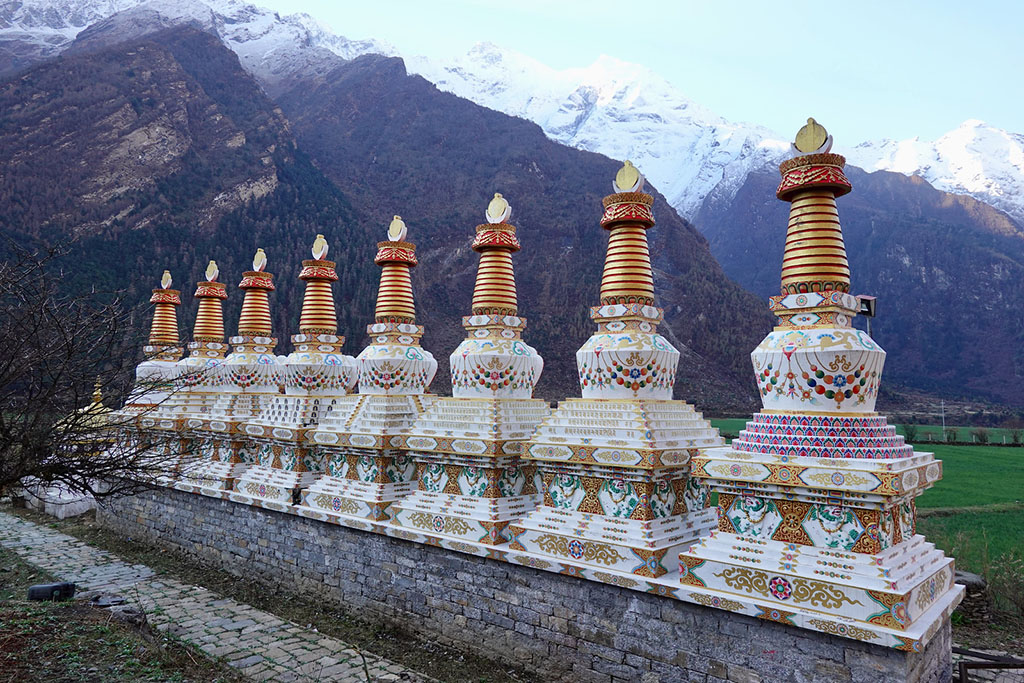
Traditional Buddhist Stupa Tsum Nubri Valley In Nepal.
Spiritual Routines.
Spirituality has a significant impact on Tsum Valley's culture. The Tsumbas are devoted Tibetan Buddhists who incorporate religious traditions into their daily life. Each residence has a modest shrine decorated with sculptures, prayer flags, and donations. The Tsumbas begin their day with mantra recitations, prayer wheels whirling, and prayers. Their home is blessed and at peace as a result of this activity. The Tsumbas also adhere to a lunar calendar, which determines the time of religious festivals and rites. Gatherings for rituals, instruction, and meditation take place at the monasteries of Tsum Valley, which function as spiritual hubs. Monks are revered figures in society, encouraging the community in matters of spirituality.
Festival in Tsum Valley.
Festivals in Tsum Valley are a colourful representation of the region's rich cultural and spiritual history. With a strong foundation in Tibetan Buddhism, the Tsumbas celebrate several festivals all year long, each with a special meaning. These celebrations serve as social gatherings that deepen ties within the community in addition to being religious occasions. The inhabitants of Tsum Valley are extremely proud of their customs, and festivals are essential to maintaining their sense of self.
Lhosar: The Tibetan New Year.
The biggest celebration in Tsum Valley is called Lhosar. It is a profound and enthusiastic celebration of the Tibetan New Year. Depending on the lunar calendar, Lhosar often occurs in February or March. Weeks in advance, the planning for Lhosar starts. Families clean and decorate their houses, and prayer flags are raised to welcome blessings in the new year. The Tsumbas perform early morning rites and domestic ceremonies on the day of Lhosar. Along with lighting butter lamps and reciting prayers, they offer sacrifices to the gods.
Following the morning ceremonies, they go to the monasteries to get the monks' blessings. People dress in their best traditional garb and share greetings, making the day joyful. Families gather to share meals and cook special foods like desserts and dumplings. Lhosar is a time for joy and celebration as well as religious observance. The Tsumbas gather in the village square to perform their traditional songs and dances. The festival's high point is these cultural acts, which emphasize the creative legacy of the valley. Lhosar is a time of celebration and unity in Tsum Valley as the whole community takes part.
Saga Dawa: The Festival of Enlightenment.
Another important celebration in Tsum Valley is Saga Dawa. One of the most sacred months in the Buddhist calendar, it honours the conception, realization, and passing of Lord Buddha. The Tsumbas celebrate Saga Dawa with great devotion, and it occurs in May or June. The inhabitants of Tsum Valley celebrate Saga Dawa with a variety of religious rituals. They pay respects, pray, and give alms to the monks when they visit them. The Tsumbas think that any good deed done during this month is double beneficial. A lot of individuals decide to travel on pilgrimages, visiting monasteries and other places of worship.
With the sound of prayers and the sight of butter candles lighting the night, the mood in the valley becomes incredibly spiritual. Saga Dawa is also a time for meditation and cleansing. During the celebration, the Tsumbas refrain from using violence against humans or other living things and consume only vegetarian food. They take part in unique ceremonies meant to accumulate merit and cleanse negative karma. The Tsum Valley people view Saga Dawa as a significant spiritual event that strengthens their commitment to Buddha's teachings.
The Landscapes in Tsum Valley.
Tsum Valley boasts some of the Himalayas' most stunning scenery. Nestled in the northern region of Nepal, this isolated valley is surrounded by high mountains, deep canyons, and peaceful meadows. It is also on the border with Tibet. Rich in both natural beauty and spiritual importance, the surroundings of Tsum Valley are a visual treat. Because of its isolation, the valley has managed to keep its natural beauty untouched, making it an ideal destination for trekkers and wildlife enthusiasts.
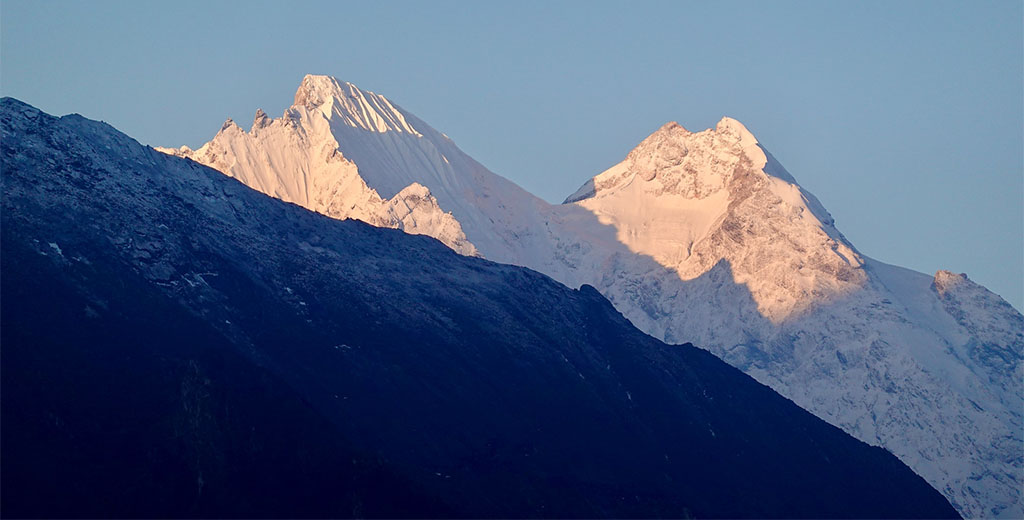
Ganesh Himal View from Tsum Valley.
Magnificent Views of Mountains
As one approaches Tsum Valley, the magnificent mountains that surround the area are what first catch one's attention. Sringi Himal, Buddha Himal, and Ganesh Himal are some of the most prominent peaks on the horizon. Visitors are in amazement at these massive, snow-capped giants as they stand tall against the clear blue sky. The mountains of Tsum Valley not only provide breathtaking vistas but also possess profound spiritual significance for those who live there.
They consider these summits holy, thinking that gods and spirits live there. Trekkers in Tsum Valley may enjoy panoramic views of these mountains at various spots along the trek. It's a continually changing scene that never gets old because of the way the light changes throughout the day, giving the peaks different tones. In Tsum Valley, the mountains offer an incredible, awe-inspiring sight, if they are illuminated by the moon or the golden light of sunrise falls on it.
Lush forests and meadows.
Not only does Tsum Valley include majestic mountains, but it also has verdant woods and peaceful meadows. Dense woods of oak, rhododendron, and pine cover the lowest portions of the valley. These woodlands are biodiverse, supporting a variety of bird, animal, and plant species. There's a calm and serene mood when strolling through these woods because of the melodic sounds of the birds and the rustling foliage.
As the route ascends, forests give way to wide meadows blooming with wildflowers in the spring and summer. Those fields with the majestic summits all around them are magnificent. As yaks and sheep are vital to the Tsumbas' way of life, they offer grazing sites for them. Tsum Valley's meadows give the rocky topography a sharp contrast while also bringing tenderness and beauty to the surroundings.
Waterfalls and Rivers.
The Siyar Khola, a river that rises from the nearby alpine glaciers, runs through the centre of Tsum Valley. The river meanders across the valley with its crystal-clear waters reflecting the blue sky and verdant woodlands. Trekkers may always count on the sound of the river running by them, offering a calming soundtrack to their trek. Several waterfalls are pouring down the rocks beside the river. The glaciers and melting snow that feed these cascades enhance the valley's natural splendour. They are particularly spectacular when they are in full flow during the monsoon season, producing a dramatic sight of water and mist. The rivers and waterfalls in Tsum Valley beautify the landscape, support local agriculture, and give fresh water to the inhabitants.
Monasteries and Mystical Caves.
Sacred caves and monasteries line the landscapes of Tsum Valley, combining natural beauty with spiritual meaning. Monks and hermits have long used the caverns, which are typically hidden in the rocks, for meditation. These locations have special significance, drawing pilgrims seeking spiritual comfort in the valley's tranquil surroundings. Tsum Valley's monasteries are typically located on slopes or set among mountain bends. Mu Gompa and Rachen Nunnery are two examples of monasteries that are not only spiritual hubs but also provide incredible views of the surrounding countryside. The contrast between man-made structures and natural surroundings generates a distinct and highly affecting beauty.
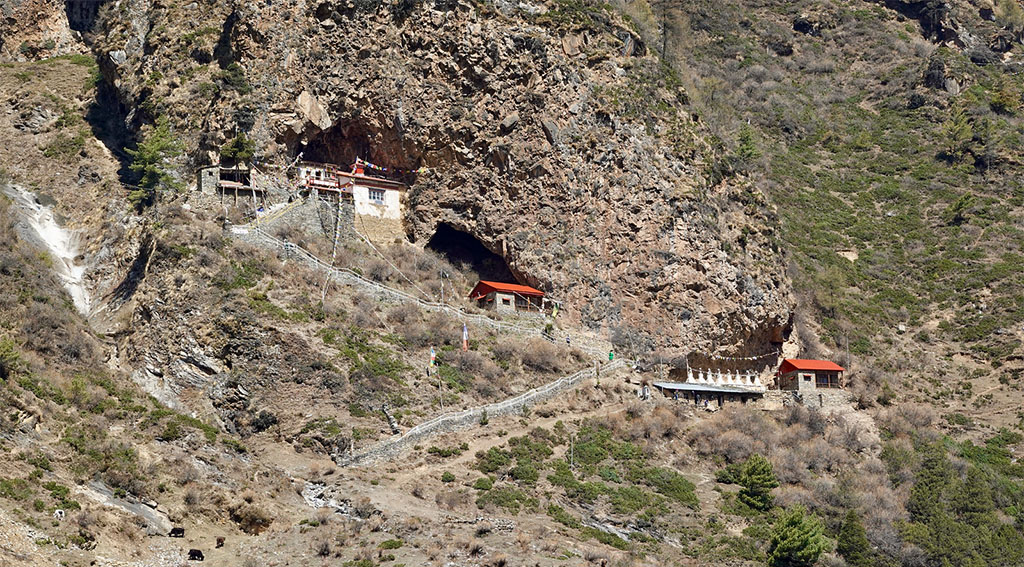
Milarepa Cave in Tsum Valley In Nepal.
Centuries-Old Buddhist Monasteries in Tsum Valley.
The Buddhist monasteries in Tsum Valley are more than simply religious structures; they serve as the valley's spiritual heart. These monasteries have gone through the test of time, protecting age-old customs and providing a haven for spiritual searchers yet nestled within the magnificent Himalayan scenery. There is a profound sense of serenity and holiness in the valley as a result of their presence, and their centuries-old walls resonate with prayers. Going to these monasteries is like travelling back in time to a place where religion and everyday life coexist.
Milarepa Cave.
One of the most valued spiritual locations in Tsum Valley is Milarepa Cave, also referred to as Milarepa's Meditation Cave. This holy cave is named after Milarepa, one of Tibet's most well-known yogis, poets, and saints. Milarepa is well-known for his extraordinary meditation achievements and insightful teachings on the path to enlightenment. It is thought that Milarepa spent years in this particular cave, hidden away high in the Tsum Valley mountains, meditating and reaching a profound state of awareness. Today, Buddhists and other spiritual seekers go from all over the world to visit the cave.
Milarepa's story is one of the most fascinating in Tibetan Buddhism. Milarepa, who was born in the eleventh century, overcame several hardships, such as a difficult upbringing and a gloomy phase of black magic practice. After recognizing the implications of his acts, he pursued spiritual redemption with the help of his guru, Marpa the Translator. Milarepa spent his entire life meditating intensely and becoming enlightened. He frequently uses music and poetry to share his teachings, which stress the value of meditation, determination, and the mind's capacity for transformation.
The Tsum Valley cave, where Milarepa practised meditation, is regarded as one of the most important locations connected to his life. Legend has it that Milarepa spent several years practising meditation in the cave, where he ate only nettles to survive and develop his spiritual life. The cave is situated in Tsum Valley, close to the location of Lama Gaon, at an elevation of around 3400 meters. Trekkers must cross roaring rivers, thick woods, and harsh terrain on their way to the cave.
The trek is challenging, but it provides magnificent views of the neighbouring mountains, notably Ganesh Himal and Sringi Himal. It's a difficult trek to reach Milarepa Cave at the highest point, but the effort is well worth it. As you approach the cave, you get a strong sensation of tranquillity and purity. The cave's entrance is marked by colourful prayer flags, and the atmosphere is filled with the prayers and aspirations of the thousands of pilgrims who have visited this blessed spot throughout the years.
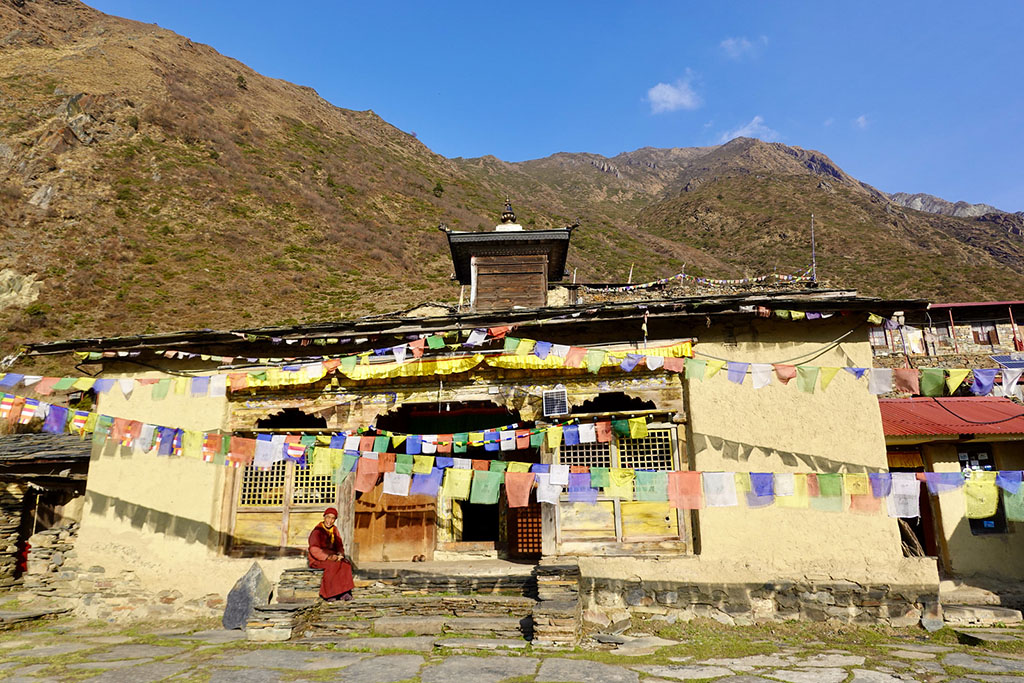
Mu Gompa Buddhist Monastery.
Mu Gompa Buddhist Monastery.
In Tsum Valley, Mu Gompa is the oldest and most significant monastery. Situated on a ridge with a view of the valley, it has an elevation of 3,700 meters. A tiny group of monks who commit their lives to prayer, study, and meditation reside at Mu Gompa, a monastery founded in the 19th century. For the residents of Tsum Valley, the monastery is an essential spiritual hub. The trip to Mu Gompa is considered a pilgrimage in itself. With the spectacular Ganesh Himal towering in the backdrop, trekkers and pilgrims take a meandering trail through grasslands and woods. Once you get to the monastery, the sight of its vibrant prayer flags flapping in the breeze and pristine walls is a sight to behold.
The monastery's interior is filled with sculptures of Buddhist deities, holy objects, and old manuscripts. The local population receives spiritual guidance from the monks who uphold the centuries-old ceremonies and customs. A hub for education and spiritual development, Mu Gompa is more than just a place of prayer. Here, the monks teach the next generation about Buddhism through studying meditation and philosophy. The calm ambiance and the monks' commitment to their work frequently leave visitors feeling deeply touched. It's a location where the old and the new blend together harmoniously.
Rachen Nunnery Gumpa.
Rachen Nunnery, located in the bottom section of Tsum Valley, is another important religious site. It was founded in the early twentieth century and now serves as a sanctuary for female Buddhist practitioners. The nunnery is home to a community of Buddhist females who live a strict monastic lifestyle centered on meditation, prayer, and studies. One of the most important things Rachen Nunnery does for the ladies of the valley is to preserve and spread Buddhist teachings. With its understated yet tasteful design, the nunnery's architecture offers glimpses of traditional Tibetan architecture. The female care after the nunnery's grounds, gardens, and prayer rooms, resulting in a tranquil and friendly environment.
Rachen Nunnery serves as the centre of social and cultural events in the neighborhood as well as being a venue for spiritual practice. The religious women who live here assist the community in many ways via their humanitarian and educational endeavours. Rachen Nunnery provides tourists with a singular opportunity to experience life as a female monastic community in Tsum Valley. The religious females are kind and engaging, frequently asking visitors to take part in their daily rites and celebrations. Nestled amidst verdant woodlands and tranquil scenery, the nunnery's setting enhances its allure as a sanctuary for individuals in search of spiritual comfort.
Dephyudonma Monastery.
One of Tsum Valley's less popular monasteries, Dephyudonma Monastery, is a hidden treasure. This is one of the valley's oldest monasteries; it is situated close to Chumling hamlet and was established in the fourteenth century. The isolated monastery has a mysterious feel to it because it sits up against the mountain. Though Dephyudonma Monastery is smaller than Rachen Nunnery and Mu Gompa, it is nonetheless very important spiritually and historically.
Ancient murals that represent scenes from Buddhist texts cover the monastery's walls, and its prayer hall is home to an extraordinary collection of sculptures and thangkas (Tibetan Buddhist paintings). While upholding the monastery's traditions and helping the neighborhood, the monks here have a simple lifestyle. Travellers who choose to walk the less-traveled way to Dephyudonma Monastery will find it to be peaceful and quiet. The monastery gets fewer tourists due to its isolated position, which makes it possible to have a more emotional and private relationship with the site. Dephyudonma Monastery is a must-see for anybody interested in learning more about Tsum Valley's spiritual legacy.

Gumba Lungdang monastery and blooming rhododendrons in Spring time.
Gumba Lungdang.
Gumba Lungdang, often referred to as Lungdang Gompa, is a not widely known yet extremely praised monastery located in Tsum Valley. This sacred location, nestled away in the isolated highlands, offers a special fusion of the beauty of nature and the peacefulness of the soul. Despite not being as well-known as Mu Gompa or Rachen Nunnery, Gumba Lungdang is very precious to the Tsumbas of the region.
It is evidence of the long-lasting spiritual customs of Tsum Valley, where everyday life and Buddhism are deeply connected. Starting at Chhokang Paro hamlet, the route winds through verdant forests, across rivers, and ascends rugged mountain routes. Though difficult, the trek offers tremendous advantages. With vistas of snow-capped peaks, rhododendron and pine woods, and the sound of the Lungdang Khola (river) rushing below, the scenery opens out in every inch of beauty as you go up.
Arriving at the monastery has even greater significance since getting to Gumba Lungdang heightens one's feeling of spiritual purpose. Based on the little available records, Gumba Lungdang is thought to have been founded centuries ago. It practices Tibetan Buddhism by the Nyingma tradition, one of the oldest schools in the country, just as other monasteries in Tsum Valley. Religious individuals who desire isolation and a closer relationship with their spiritual practice may return to the monastery.
Gumba Lungdang's isolation gives it the perfect location for contemplation, prayer, and meditation. The actual monastery is small in size and has exquisitely basic construction. Its whitish walls, draped with prayer flags, are in sharp contrast to the surrounding lush and beautiful scenery. The main prayer hall within is an epicentre of peace and quiet filled with rows of flickering butter lamps, thangkas (Tibetan Buddhist artwork), and sculptures of Buddhist deities. The aroma of incense and the sound of chanting fill the air, evoking a profound sense of spiritual devotion.
Wildlife and Biodiversity in Tsum Valley.
Tsum Valley is a secret biodiversity and animal hotspot. This valley is hidden in Nepal's far north, beneath the Sringi Himal and Ganesh Himal mountain ranges. Many different types of flora and wildlife find shelter in its solitude and varied ecosystems. Tsum Valley is a vital location for conservation and a nature lover's dream because of its distinct climate and terrain, which both contribute to its abundant biodiversity.
Distinctive Ecosystem.
There are many habitats in Tsum Valley. This remote area is home to alpine meadows, glacial rivers, and dense woods. These diverse ecosystems sustain a wide range of plant and animal life. Subtropical woods grow in the valley's lower parts. You may find oak, pine, and rhododendron trees here. As altitude rises, the flora changes to alpine meadows, which are home to tough grasses and medicinal plants. The highest regions, near glaciers, are gloomy and rocky, yet they have their own beauty and biological significance. Tsum Valley is home to a diverse range of animal species, including some rare and endangered species.
The higher altitudes are home to the rare snow leopard. You may see Himalayan blue sheep grazing on the high hills while trekking through the valley. Snow leopards consume these animals, which are an essential component of the ecology. Other creatures like the musk deer and the Himalayan tahr live in the valley as well. The latter is especially significant since it produces musk, which is utilized in traditional medicine.
Conservation initiatives strive to safeguard these species, which are under threat from habitat loss and poaching. You may spot the langur monkey in the wooded woods, jumping from tree to tree, with its characteristic black face and long tail. Tsum Valley is an essential conservation area because of the diversity of animals that live there.

White Rumped Vultures In Tsum Valley.
Birdlife and Flora in Tsum Valley.
Tsum Valley is an absolute delight for birdwatchers. The valley supports a diverse range of bird species, including numerous rare and endangered species. In the highlands, the national bird of Nepal, the Himalayan monal, shows off its shimmering feathers. With its amazing wingspan against the backdrop of mountains, the giant bearded vulture known as the lammergeier flies far over the valley. The sounds of laughing thrushes, pheasants, and cuckoos resound across the valley's woodlands. The variety of birds in this area demonstrates the natural richness of the valley.
Tsum Valley is abundant in plant life as well. Because of the valley's remoteness, several species have been able to flourish there unhindered. Rhododendron blooms in the spring provide the hillsides with a riot of colour. These vivid blooms are essential to the surrounding ecology in addition to being aesthetically pleasing. There are a lot of therapeutic plants in the valley. These plants are essential to the local economy and are used in traditional medicine by the locals.
The wildlife in Tsum Valley gets its food and shelter from the valley's vegetation. Mammals and birds can find homes in the pine, fir, and juniper forests that blanket much of the valley. Because of the diversity of plants in the area, a wide range of insects and tiny animals are supported, which in turn benefits bigger predators.
Trekking to Tsum Valley is a lifetime travel experience with wonderful Tsum Valley culture, and traditions. We, Visit Himalaya Treks operate fully trekking holidays over Tsum Valley combined with Manaslu Circuit via Larkya La Pass. Look at our Manaslu Tsum Valley Trek Package for your wonderful trekking holidays in Nepal.











